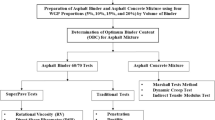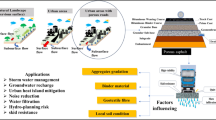Abstract
In Québec, for more than 20 years, cold in-place recycling (CIR) and full-depth reclamation (FDR) have been reliable rehabilitation techniques; restoring pavement condition at an affordable cost with a lower footprint on the environment. Experience reveals that CIR and FDR interventions effectively address the issues of reflective cracking and respect Québec’s Ministry of transportation rutting threshold values. However, despite their commendable performance in the field, the cold recycled emulsified asphalt materials (CRM) has yet to be adequately characterized with respect to their rheological properties. This study was undertaken to evaluate the rheological behavior of the CRM with four different combinations of RAP (50, 75, 85, and 100%). The scope of work for this study consisted of preparing the laboratory compacted CRM specimens, determining the complex modulus (E*) of compacted specimens at various testing temperatures and loading frequencies, analyzing the experimental data with the help of 2S2P1D (2S: two springs, 2P: two parabolic elements, 1D: one dashpot) model and finally, validating the results with pavement design. It was concluded that 100% RAP mixture exhibits extremely high stiffness value at high frequency and low temperature. The results revealed that all four mixtures respect the time–temperature superposition principle with respect to the complex modulus. From a pavement design perspective, the moduli measured in this study do have a big impact. However, since different pavement structure are achieved with those different materials, the stiffest material, the CIR, ended up giving the least performant structure.






Similar content being viewed by others
References
Recycling A, and Reclaiming Association ARRA (2001) Basic asphalt recycling manual (BARM). Annapolis, Maryland
Epps JA, Allen DD (1990) Cold-recycled bituminous concrete using bituminous materials, no. 160. Transportation Research Board
Kandhal PS, Mallick RB (1998) Pavement recycling guidelines for state and local governments participant’s reference book. Publication Numbers: FHWA-SA-98-042, Washington, 1998
Salomon A, Newcomb DE (2000) Cold in-place recycling literature review and preliminary mixture design procedure, Report No. MN/RC-2000-21, Minnesota, USA
Carter A, Feisthauer B, Lacroix D, Perraton D (2010) Comparison of cold in-place recycling and full-depth reclamation materials. In: Transportation research board 89th annual meeting, Report No. 10–1325, Washington DC, United States
Witczak M, Fonseca O (1996) Revised predictive model for dynamic (complex) modulus of asphalt mixtures. Transp Res Rec J Transp Res Board 1540:15–23
Pérez I, Medina L, del Val MÁ (2013) Mechanical properties and behaviour of in situ materials which are stabilised with bitumen emulsion. Road Mater Pavement Des 14(2):221–238
Carter A, Herman A, Perraton D, Ortega F (2008) Rutting resistance and complex modulus of cold in-place recycled materials. In: Proceedings of the Fifty-third Annual Conference of the Canadian Technical Asphalt Association (CTAA)
Stimilli A, Ferrotti G, Graziani A, Canestrari F (2013) Performance evaluation of a cold-recycled mixture containing high percentage of reclaimed asphalt. Road Mater Pavement Des 14(sup1):149–161
Carter A, Buesche N, Perraton D (2013) Laboratory characterization of CIR and FDR materials. In: 3rd Specialty Conference on Material Engineering and Applied Mechanics
May RW (2008) The challenges to innovation with the MEPDG-case study: cold recycled mixtures (With Discussion). J Assoc Asph Paving Technol 77:985–1004
Thomas T, Kadrmas A (2003) Performance-related tests and specifications for cold in-place recyclinng: lab and field experience. In: CD-ROM of TRB 82th Annual Meeting, Washington, 1–14
Gandi A, Kagabo J, Carter A, Singh D (2015) Study of the use of confining pressure when measuring the complex modulus of full-depth reclamation materials. In: Proceedings of the Sixtieth Annual Conference of the Canadian Technical Asphalt Association (CTAA): Ottawa, Ontario
Twagira ME, Jenkins KJ, Ebels LJ (2006) Characterization of fatigue performance of selected cold bituminous mixes. In: 10th International conference on asphalt pavements-august 12–17, 2006, Quebec, Canada
Godenzoni C, Graziani A, Bocci M (2015) Influence of reclaimed asphalt content on the complex modulus of cement bitumen treated materials. In: 6th International conference bituminous mixtures and pavements, Thessaloniki (Greece), 589–596
Carter A, Perraton D (2002) La mesure du module complexe des enrobés bitumineux. In: 2e Conférence spécialisée en génie des matériaux de la Société canadienne de génie civil, 10
Di Benedetto H, De La Roche C (1998) State of the art on stiffness modulus and fatigue of bituminous mixtures. RILEM Rep 17:137–180
Di Benedetto H, Olard F, Sauzéat C, Delaporte B (2004) Linear viscoelastic behaviour of bituminous materials: from binders to mixes. Road Mater Pavement Des 5:163–202
Olard F, Di Benedetto H (2003) General ‘2S2P1D’ model and relation between the linear viscoelastic behaviours of bituminous binders and mixes. Road Mater Pavement Des 4(2):185–224
Mangiafico S, Di Benedetto H, Sauzéat C, Olard F, Pouget S, Planque L (2014) New method to obtain viscoelastic properties of bitumen blends from pure and reclaimed asphalt pavement binder constituents. Road Mater Pavement Des 15(2):312–329
Tapsoba N, Sauzéat C, Di Benedetto H, Baaj H, Ech M (2014) Behaviour of asphalt mixtures containing reclaimed asphalt pavement and asphalt shingle. Road Mater Pavement Des 15(2):330–347
Ferry JD (1980) Viscoelastic properties of polymers. Wiley, New York
ASTM D6307-10 (2010) Standard test method for asphalt content of hot-mix asphalt by ignition method, West Conshohocken
MTQ, LC 26-002 (2001) Méthode de formulation à froid des matériaux recyclés stabilisés à l’émulsion, Gouvernement du Québec
Singh D (2011) A laboratory investigation and modeling of dynamic modulus of asphalt mixes for pavement applications. The University of Oklahoma
Nguyen HM, Pouget S, Di Benedetto H, Sauzéat C (2009) Time-temperature superposition principle for bituminous mixtures. Eur J Environ Civ Eng 13(9):1095–1107
Di Benedetto H, Partl MN, Francken L, Saint André CDLR (2001) Stiffness testing for bituminous mixtures. Mater Struct 34(2):66–70
Godenzoni C, Graziani A, Perraton D (2016) Complex modulus characterisation of cold-recycled mixtures with foamed bitumen and different contents of reclaimed asphalt. Road Mater Pavement Des 18(1):130–150
Author information
Authors and Affiliations
Corresponding author
Rights and permissions
About this article
Cite this article
Gandi, A., Carter, A. & Singh, D. Rheological behavior of cold recycled asphalt materials with different contents of recycled asphalt pavements. Innov. Infrastruct. Solut. 2, 45 (2017). https://doi.org/10.1007/s41062-017-0094-3
Received:
Accepted:
Published:
DOI: https://doi.org/10.1007/s41062-017-0094-3




